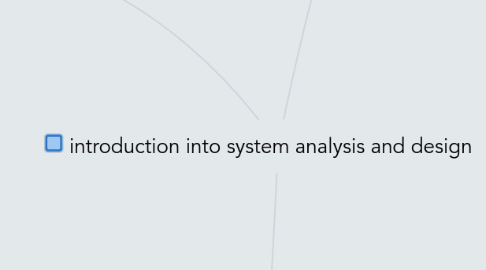
1. 1.3 understand project management
1.1. 1.3.1 Explain project planning, scheduling, monitoring, and reporting.
1.2. 1.3.2 Explain steps in project planning.
1.3. 1.3.3 Describe work breakdown structures, task patterns, and critical path analysis.
1.4. 1.3.4 Create a work breakdown structure.
1.5. 1.3.5 Explain techniques for estimating task completion times and costs.
2. 1.1 Discuss information system
2.1. 1.1.1 define information and information system
2.1.1. information is data that has been transformed into output that is valuable to users.
2.1.2. information system is combines information technology, people and data to support business requirements
2.2. 1.1.2 describe information system components.
2.2.1. Hardware : Is the physical layer of the information system
2.2.2. Software : System software Application software Enterprise applications
2.2.3. Data -Tables store data -Linked tables work together to supply data
2.2.4. Processes -Describe the tasks and business functions that users, managers, and IT staff members perform to achieve specific results
2.2.5. people:- Stakeholders - Users, or end users
2.3. 1.1.3 identify various types of information system
2.3.1. -executives
2.3.2. senior managers
2.3.3. middle managers
2.3.4. workers
3. 1.2 discuss system development approach
3.1. 1.2.1 explain system development method
3.1.1. a. Structured analysis
3.1.1.1. a traditional systems development technique that is time tested and easy to understand.
3.1.2. b. Object oriented analysis
3.1.2.1. a popular technical approach for analyzing, designing an application, system, or business by applying the object-oriented paradigm and visual modeling throughout the development life cycles to foster better stakeholder communication and product quality.
3.1.3. c. Agile/adaptive method
3.1.3.1. refers to an iterative, incremental method of managing the design and build activities of engineering, information technology and other business areas that aim to provide new product or service development in a highly flexible and interactive manner.
3.2. 1.2.2 Explain System Development Life Cycle (SDLC) activities
3.2.1. a Planning
3.2.1.1. This is the first phase in the systems development process. It identifies whether or not there is the need for a new system to achieve a business’s strategic objectives.
3.2.2. b. Analyze
3.2.2.1. The second phase is where businesses will work on the source of their problem or the need for a change.
3.2.3. c. Design
3.2.3.1. The third phase describes, in detail, the necessary specifications, features and operations that will satisfy the functional requirements of the proposed system which will be in place.
3.2.4. d. Development
3.2.4.1. The fourth phase is when the real work begins—in particular, when a programmer, network engineer and/or database developer are brought on to do the major work on the project.
3.2.5. e. Testing
3.2.5.1. The fifth phase involves systems integration and system testing (of programs and procedures)—normally carried out by a Quality Assurance (QA) professional—to determine if the proposed design meets the initial set of business goals.
3.2.6. f. Implementation
3.2.6.1. The sixth phase is when the majority of the code for the program is written. Additionally, this phase involves the actual installation of the newly-developed system. This step puts the project into production by moving the data and components from the old system and placing them in the new system via a direct cutover.
3.2.7. g. Maintenance
3.2.7.1. The seventh and final phase involves maintenance and regular required updates.
3.3. 1.2.3 Describe various types of life cycle models
3.3.1. a. Waterfall model
3.3.1.1. Represents the system in terms of data and the processes that objects that act upon that data
3.3.2. b. Spiral Model
3.3.2.1. Spiral Model is a combination of a waterfall model and iterative model. Each phase in spiral model begins with a design goal and ends with the client reviewing the progress.
3.3.3. c. Iterative and incremental development
3.3.3.1. Develop a system through repeated cycles (iterative) and in smaller portions at a time (incremental), allowing software developers to take advantage of what was learned during development of earlier parts or versions of the system.
3.3.4. d. Agile Model
3.3.4.1. Agile methods attempt to develop a system incrementally, by building a series of prototypes and constantly adjusting them to user requirements.
3.3.5. e. Prototyping model
3.3.5.1. -A prototype is an early working version of an information system. -Prototyping tests system concepts and provides an opportunity to examine input, output, and user interfaces before final decision are made.
3.3.6. f. Rapid Application Development (RAD)
3.3.6.1. is a team-based technique that speeds up information systems development and produces a functioning information system.
3.3.7. g. Joint Application Development (JAD)
3.3.7.1. -a popular fact-finding technique that brings users into the development process as active participants. -A JAD team usually meets over a period of days or weeks to analyze the existing system, obtain user input and expectations, and document user requirements for the new system.
3.4. 1.2.4 Identify appropriate life cycle models based on given scenario
3.5. 1.2.5 Describe project management activities
3.5.1. a. planning
3.5.1.1. identifying all project tasks and estimating the completion time and cost of each.
3.5.2. b. scheduling
3.5.2.1. the creation of a specific timetable, usually in the form of charts that show tasks, task dependencies, and critical tasks that might delay the project. Scheduling also involves selecting and staffing the project team and assigning specific tasks to team members.Project scheduling uses Gantt charts and PERT/CPM charts
3.5.3. c. monitoring
3.5.3.1. requires guiding, supervising, and coordinating the project team’s workload. The project manager must monitor the progress, evaluate the results, and take corrective action when necessary to control the project and stay on target.
3.5.4. d. reporting
3.5.4.1. includes regular progress reports to management,users, and the project team itself. Effective reporting requires strong communication skills and a sense of what others want and need to know about the project.

